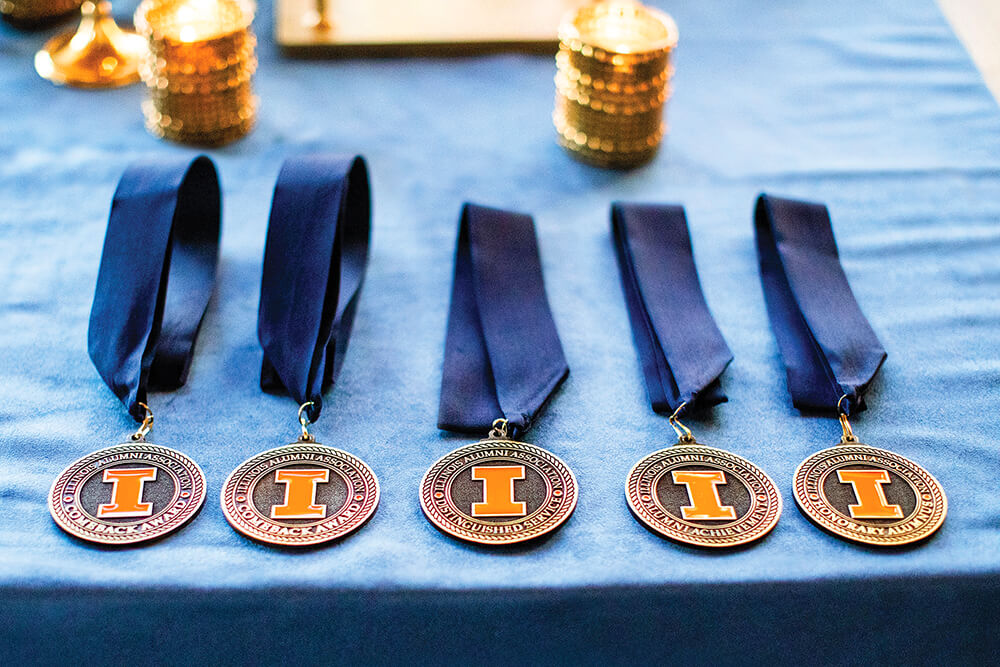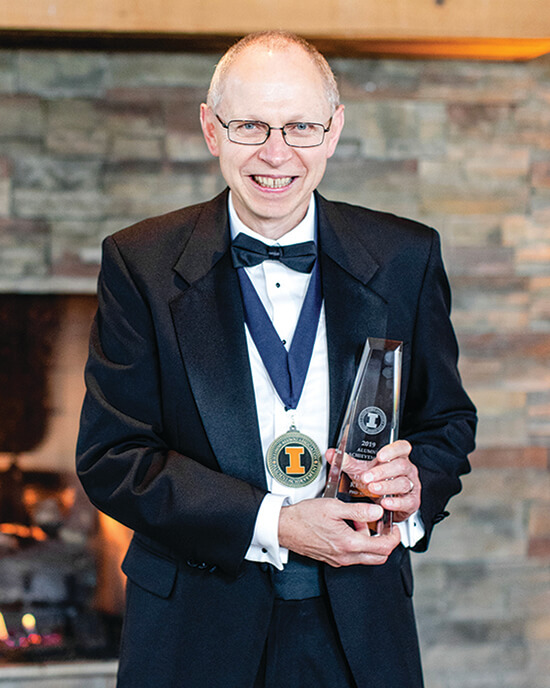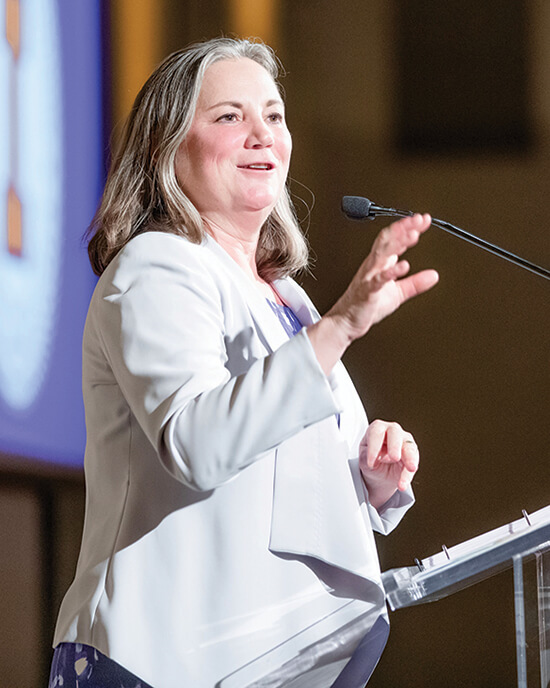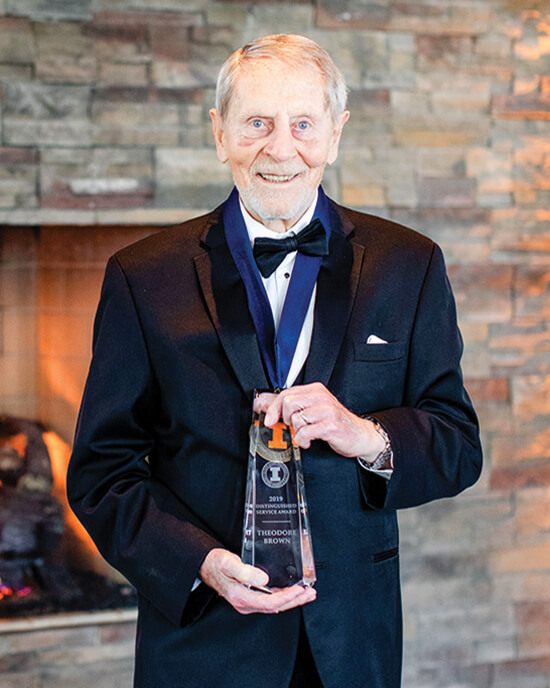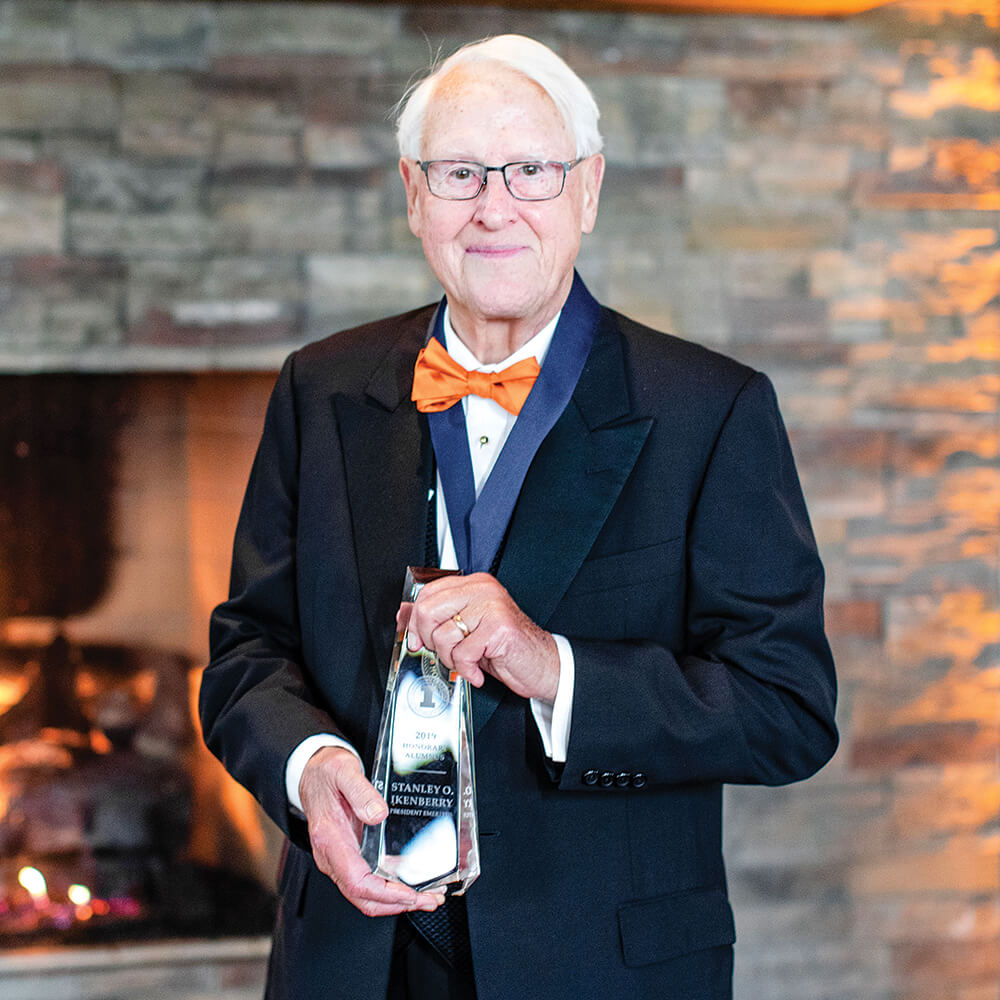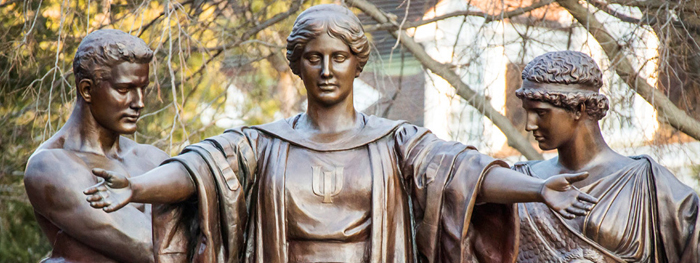2019 ALUMNI AWARDS
ALUMNI ACHIEVEMENT AWARD
CURATIVE CHEMIST
Dale Kempf followed his groundbreaking research on HIV/AIDS and hepatitis C by focusing on neglected diseases
In 1991, the AIDS epidemic was raging and there seemed to be little hope for a cure. But at Abbott Laboratories in suburban Chicago, a young chemist named Dale Kempf, PHD ’82 LAS, was learning otherwise.
His team had been working for four years on a drug that could prevent HIV from replicating. That year, they completed the third iteration of their compound, and during testing on rats, the drug remained in the bloodstream for long periods of time at high concentrations. Kempf sensed that a breakthrough was just around the corner.
“It looked exceptional compared to all of the previous compounds,” Kempf recalls. “That was an ‘a-ha!’ moment, and we put [the drug on the fast track] toward development.”
That drug, called ritonavir and marketed as Norvir, received FDA approval in 1996, and along with parallel offerings such as Roche’s saquinavir and Merck’s indinavir, marked a turning point in the fight against HIV/AIDS. For Kempf, a Mennonite from rural Nebraska who chose the pharmaceutical industry over an academic career because he perceived a greater opportunity to make a difference, it was both validation and a dream come true.
Norvir represented a big step forward in HIV medication, but it wasn’t a silver bullet; there was more work to be done. While studying Norvir’s effects, Kempf’s team at Abbott noticed that the drug had a second useful trait—not only did it impede HIV replication, it also inhibited a pathway in the liver that neutralized protease inhibitors. That discovery led to a second breakthrough: Low doses of Norvir acted as a “pharmacokinetic booster” that dramatically enhanced the effects of a second protease inhibitor when they were administered together. That approach became the basis for Kaletra, Abbott’s landmark HIV medication that gained FDA approval in 2000 and is still in use.
Kempf’s HIV/AIDS work constituted a career-making accomplishment. Indeed, in 2003 he was named a “Hero of Chemistry” by the American Chemical Society for his work on Kaletra, and is also a Distinguished Research Fellow at Abbott—the company’s top designation for scientists.
By 2003, however, Kempf had already moved on to applying the protease inhibitor concept to hepatitis C. This time, he led a team of chemists that worked alongside a team of biologists and their combined efforts paid dividends. The combination drugs Viekira Pak and Mavyret, released in the U.S. by AbbVie in 2014 and 2017, respectively, have joined Norvir and Kaletra on the World Health Organization’s Model List of Essential Medicines. (Abbott Laboratories spun off its drug-making unit in 2013 under the name AbbVie, and Kempf is now an AbbVie employee.)
Even though Kempf’s hepatitis C drug only recently hit the market, his work on the discovery phase of the program ended in 2010. For most of this decade, he’s focused on developing drugs to address health issues farther from the spotlight and less likely to receive big-budget funding: neglected diseases afflicting third-world populations.
AbbVie’s interest in those diseases stems from a challenge made by the Bill & Melinda Gates Foundation to the world’s largest pharmaceutical companies. AbbVie executives asked Kempf to join a multiple-organization scientific advisory group that would examine the issues. Kempf was so inspired by the initial meeting of that team that he soon asked AbbVie if he could work on neglected diseases full time—and his request was granted.
That work is paying dividends. While studying river blindness in Africa, for example, Kempf and his team searched AbbVie’s library of compounds and identified a veterinary antibiotic that might be effective against the disease. They have since modified that compound, and a phase II clinical trial is slated to begin next year in the Democratic Republic of the Congo.
River blindness doesn’t have quite the same headline-grabbing or commercial potential as HIV/AIDS or even hepatitis C, but for Kempf, “being able to devote my time and expertise to these underserved disease areas at this point in my career—well, it’s like a gift.”
Kempf, who’s spent more than 35 years at the same company developing one blockbuster drug after another, says he has finally found his place. “I tell people I have the best job in the company, and I believe it.”—Steve Hendershot
ALUMNI ACHIEVEMENT AWARD
BIOMEDICAL PIONEER
Laura Niklason breaks new ground at the intersections of engineering and biology, medicine and physics
“I think I was a girl in a hurry,” says Dr. Laura Niklason, ’83 LAS, ’83 LAS, who enrolled at Illinois at the age of 16 after skipping a grade in elementary school and finishing high school in three years. If that wasn’t ambitious enough, she double majored in biophysics and physics.
Niklason found it “a tiny bit scary” to enter college at such an early age, but speculates that the students who were two years older than her were probably experiencing similar feelings. Plus, she had a role model—her mother—who entered the University of Chicago as a 15-year-old to study biochemistry. She met Niklason’s father, a chemist, there.
Now an acclaimed pioneer in biomedical research and regenerative medicine because of her success growing bioengineered blood vessels from human tissue, Niklason shows no signs of slowing down. If possible, she appears to be moving faster.
Niklason is a professor of anesthesiology and biomedical engineering, and vice chair for research in the Yale School of Medicine Dept. of Anesthesiology. In 2004, while a professor at Duke University, Niklason founded a biotechnology startup company, Humacyte, in the North Carolina Research Triangle, where work on the engineered blood vessel she invented has steadily advanced. Officially known as human acellular vessels (HAVs), the medical breakthrough has been fast-tracked for FDA approval and is currently in phase III clinical trials. And 12 years ago, Niklason expanded her groundbreaking research at Humacyte to explore the bioengineered growth of human lung tissue.
Niklason cannot recall the name of the premed counselor at Illinois who informed her during her sophomore year that her plan to pursue a career in biomedical research would require her to complete medical and doctoral programs. But she does “vividly remember coming out of the meeting and blinking at the sunlight” as she realized that the education towards her career path would take four years longer. Niklason is grateful for the support and encouragement she received from her early mentor, Steven Zumdahl, PHD ’68 LAS, professor emeritus of chemistry at Illinois.
After graduating with honors and receiving the University’s Bronze Tablet, Niklason earned her Ph.D. in biophysics at the University of Chicago and her medical degree at the University of Michigan. In 1992, she began a residency at Massachusettes General Hospital in Boston. It was there that she began her exploration into engineered blood vessels.
“One of my first mentors, Chuck Vacanti, showed me images of new cartilage that he had grown in the skull of a living rat,” Niklason recalls. “And I thought, ‘Growing tissue from scratch—that has to be the coolest thing ever!’ That’s what headed me down this path.”
She says the driving motivation behind her work was the suffering she witnessed among critically ill patients during her clinical work. “Medically, I became focused on taking care of patients in the ICU, and by extension, more interested in replacing or repairing tissues,” Niklason explains.
“What attracted me to this nascent field of tissue engineering and regenerative medicine was that it allowed me to take advantage of what I think are my strengths,” she says. “I was trained pretty broadly in the sciences. I think of myself as a jack-of-all-trades, master of none, in the sense that all of my work has been at the interface between engineering or biology or medicine or physics. I’ve been able to become a master of the tissue engineering paradigm because I’ve been able to bridge across different areas into this unique little niche.”
Niklason’s work has led to numerous professional honors. In 2010, an engineered lung she developed received recognition in Time magazine’s “50 Best Inventions.” In 2014, she was inducted into the National Academy of Inventors, and a year later, elected to the National Academy of Medicine. In 2017, she was inducted into the Women in Technology Hall of Fame and included in Fortune magazine’s list of “34 Leaders Who Are Changing Health Care.” Finally, earlier this year, Humacyte received the Large Project Prototype of the Year Award from the Medical Technology Enterprise Consortium.
Niklason says receiving an alumni award is a big deal for her. “I’m very flattered and honored,” she says. “The U of I really shaped my brain, in terms of the way I think. I fall back on what I learned there every single day.”—Paul Engleman
DISTINGUISHED SERVICE AWARD
COLLABORATION CATALYST
Through his support of the Beckman Institute, Theodore L. Brown helped create the model for modern, interdisciplinary research universities
Like most people during the Great Depression, Theodore L. “Ted” Brown’s family didn’t have much money, but he remembers asking for a chemistry set for Christmas. He got his wish, and even remembers the little bench in the basement of their Green Bay, Wis., home on which he placed his set.
That memory is just one he recalled as he began writing his memoir this past summer. “I figured I better get started,” he says with good humor, just days before his 91st birthday. “You don’t think you remember much, but things come to you, especially where you start writing.”
Brown has a lot to write about, much of it focusing on his U of I service. His contributions go above and beyond his tenure as a chemistry professor. He played a critical role in shaping Illinois as a leading research institution by helping to launch and serving as the founding director of the Arnold O. and Mabel M. Beckman Institute for Advanced Science and Technology.
In support of Brown’s nomination for the Distinguished Service award, Art Kramer—who worked with Brown to establish the Beckman Institute, later served as its director and is now a senior vice provost at Boston’s Northeastern University—commended his colleague for his “steady administrative hand, willingness to think outside the box, credibility as a first-rate scientist and the respect in which he was held by the Beckmans.” He adds, “In essence, Ted wrote the book that many universities have subsequently used to construct their own institutes.”
Now a professor emeritus of chemistry, Brown sees his 37 years of service not as a whole, but as a collection of distinct careers as an educator, author, administrator and activist. Brown was a Michigan State University graduate student and recipient of a DuPont Fellowship when Illinois called and offered him a teaching position. “My wife Audrey, ’89 LAS, and I went to Illinois with our two children, thinking it would give me a chance to try my wings at teaching. We settled down, and I never left,” he says.
For 25 years, he taught general chemistry to undergraduates, mentored graduate students and engaged in research. At the same time, he pursued his second career as an author. Brown and co-author H. Eugene LeMay, MS ’64 LAS, PHD ’66 LAS, wrote Chemistry: The Central Science. Now in its 14th edition—co-authored with four others—it remains a bestseller. In addition to his published work on the cognitive, philosophical and social aspects of the scientific enterprise, Brown has written a widely cited book exploring metaphorical scientific reasoning. Last year, he published a work of historical fiction.
As Brown taught and wrote, he discovered he had gifts for what became yet another career: administration. He was appointed dean of the Graduate College and vice chancellor for research (1980–86), helping to usher in a new era that led to the Beckman Institute.
The groundwork laid came to fruition in a $40 million gift from Arnold and Mabel Beckman for the Beckman Institute. Brown became its acting director, then founding director. He calls it “the most demanding and rewarding” of his careers.
Of late, he has become deeply concerned about climate science and change, and in his latest career as an activist, he blogs regularly at scienceoracle.blogspot.com about using science and technology to address environmental issues. “There are things we can do,” he says.
“I’m deeply grateful to the University for the opportunities it provided me to pursue each career. It’s a remarkable institution,” he says. Although the Browns now live in Florida and spend summers on a small lake in Michigan’s Upper Peninsula with their family—four children (two are U of I alumni), eight grandchildren and 10 great-grandchildren, Ted and Audrey frequently return to Illinois where they created two undergraduate scholarship funds in the College of Liberal Arts and Sciences. In addition, the Arnold and Mabel Beckman Foundation endowed the University with a postdoctoral fellowship and an annual Beckman-Brown lecture. Recently, the Browns returned for the Beckman Institute’s 30th anniversary.
“It brings me back to Illinois, which is delightful,” he says. “The feeling I get when I walk in the door is satisfaction and accomplishment, due to so many people working collaboratively.”—Julie Sevig
HONORARY ALUMNUS
PRESIDENT. TWICE.
After Stanley O. Ikenberry transformed the University of Illinois, he came back for an encore
When, after a 14-year absence, life’s cosmic revolving door opened in 2009 to redeposit Stanley O. Ikenberry behind the desk of the president of the University of Illinois System, he noticed an important difference in the once-familiar surroundings.
“My desk now had a computer on it,” the veteran administrator says. “And that was both good and bad.”
It’s a disarming recollection. The University of Illinois at Urbana-Champaign became one of the world’s most technologically enabled institutions of higher education on Ikenberry’s first watch as president (1979–95). The National Center for Supercomputing Applications (NCSA) evolved from a conversation between Ikenberry and engineering professor Larry Smarr that led to the University becoming home to one of the world’s top supercomputing facilities.
And then there was the Arnold O. and Mabel M. Beckman Institute for Advanced Science and Technology, which brings faculty together across disciplines to address complex research questions. Opened in 1989, just three years after NCSA, the Institute created a paradigm for interdisciplinary research in the sciences “far beyond anything that anybody at that time had envisioned at an American university,” in Ikenberry’s view. His imprint on the campus also included the Grainger Engineering Library Information Center.
All that growth was guided by a fresh campus master plan that Ikenberry spearheaded. “Today, thanks to Stanley’s planning, you can look down from the Beckman Tower and see four quads—a central campus spine with buildings clustered around green spaces,” says Lex Tate, ’72 MEDIA, a journalist and U of I historian. “It is gorgeous.”
Tate observes that at Illinois facilities burgeoned by more than 3.3 million square feet, and the System as a whole gained more than 60 million square feet in 50 new and renovated buildings. One site even carries Ikenberry’s name. The University board of trustees designated a state-of-the-art residence and dining hall complex on the Urbana campus as Ikenberry Commons.
Ikenberry—who had previously served as senior vice president of The Pennsylvania State University—stepped into the University of Illinois presidency at age 44, the youngest person ever to hold the job. Departing 16 years later, he also would be among the longest-serving. The time between was a period of systemwide progress. Among Ikenberry’s proudest achievements was forging the University of Illinois at Chicago. During the Ikenberry administration, Sangamon State University also became the University of Illinois Springfield.
Ikenberry’s success has sprung from his ability to get things done and still have people like him. “It’s hard to find administrators who can deal in the academic world and the political world and also in the corporate world of Chicago,” notes former Illinois Governor Jim Edgar. “Stan was very good at all three.” Ikenberry worked well with governors, legislators and CEOs. He also sought the counsel of alumni, faculty, staff and students.
Ikenberry retired in 1995 as president emeritus. He next held leadership posts in education, including a term as the 10th president of the American Council of Education (1996–2001) and as president of the Board of Overseers at TIAA-CREF, a leading retirement financial services organization for U.S. college and university employees. He returned to the U of I in 2001, teaching in the College of Education and the Institute of Government & Public Affairs.
Then in 2009, he was summoned to an unexpected second term as interim leader to shepherd the UI System through a months-long crisis. (See “Admissions Reforms Underway,” pgs. 6–7, Illinois Alumni, September/October 2009.)
“He was tremendous to work with,” recalls Bob Easter, who served as interim chancellor at Illinois during that time. “He was firm when he needed to be firm. But you always had an opportunity to tell him what you thought.” Looking back, Ikenberry remains humble. “I was amazed to have a computer, though I managed to waste a lot of time answering my email,” he demurs. “But it was wonderful to go back for that year.”
Jennifer Dillavou, ’82 ED, president of the University of Illinois Alumni Association, lauds the first Honorary Alumni Award recipient for both transforming the University and guiding it through a difficult time. “As an iconic president, he set standards for vision, integrity, dedication and spirit that remain hallmarks for leadership,” she notes. “By welcoming him into the ranks of our alumni, we elevate ourselves.”—Mary Timmins

